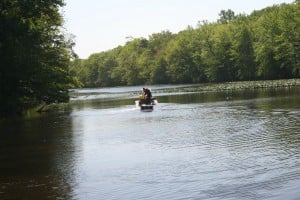

Camden County officials will soon release a new report outlining the need to dredge Kirkwood Lake to prevent lead- and arsenic-contaminated sediment from flowing downstream to the Cooper River and to prevent the ultimate death of the lake itself.
At a public meeting on April 7 at the Voorhees Town Center, Camden County Freeholder Jeff Nash and other county officials gave a summary of the study, which Nash said is close to being finalized by the Sadat Associates environmental and civil engineering firm.
According to Pete Fontaine, and environmental attorney the county hired, the report effectively concludes the lake is becoming progressively shallower, presenting a danger to the surrounding area and Cooper River.
Fontaine said the lake was reported to have an original depth of around nine-and-a-half feet, but that number had decreased to four-and-a-half feet by 1979 in a study performed by the state Department of Environmental Protection.
Until the 1970s, Sherwin-Williams and John Lucas & Company operated a paint, varnish and lacquer manufacturing facility upstream in neighboring Gibbsboro for more than a century.
During that time, there were decades of direct discharge of materials to the Hilliards Creek that eventually discharged into Kirkwood Lake in Voorhees, leaving the lake with sediment contaminated with with lead and arsenic.
The lake currently sits at a depth of about two to two-and-a-half feet, meaning it lost about another two feet of depth in these last 30 years.
Fontaine said the shallowness of Kirkwood Lake leads to a diminished carrying capacity, and in the event of a significant storm, there would be a significant scouring of sediments and the potential for significant amounts of lead and arsenic to be transported downstream to the Cooper River in suspended sediments.
Fontaine said dredging the lake would solve both issues.
“You solve that problem of having significant contamination near the surface and you increase the capacity of the lake to serve effectively as a sedimentation basin, which it has served that role for many years really since it was first created back in the 1800s,” Fontaine said.
However, as Camden County Municipal Utilities Authority executive director Andy Kricun explained, dredging the lake is not a simple process.
Since Kirkwood lake is already part of a Superfund Project where cleanup efforts are managed by the Environmental Protection Agency, Kricun said if the county moved forward with dredging the lake without first working out some type of legal agreement with the EPA and Sherwin-Williams, the county would be taking over some of the contamination liability that already belongs to Sherwin-Williams.
However, under the EPA’s schedule for determining cleanup methods for areas within the Sherwin-Williams Superfund Site, Kirkwood Lake currently ranks last in priority. Kirkwood Lake is downstream from the other areas, and there is a fear of possible recontamination of the lake if the cleanup areas upstream are not handled beforehand.
Regarding Kirkwood Lake, the EPA won’t have a Record of Decision, the final public document outlining the cleanup of a site, until 2018 or 2019.
The first cleanup method finalized by the EPA was announced in September and related to residential sites for in Gibbsboro, Lidenwold and Voorhees adjacent to the other contaminated areas.
Remaining decisions ahead of Kirkwood Lake are the Route 561 Gibbsboro dump site once used for Sherwin-Williams disposal activities, the Gibbsboro United States Avenue burn site once used for landfilling of wastewater material and the former Gibbsboro manufacturing plant itself.
Once the EPA reaches a cleanup decision for a site, years of design and cleanup work can then remain before a site is fully remediated.
“What we’re trying to do is expedite dredging of the lake without adding the county to legal exposure, which wouldn’t be right for any of the ratepayers in Camden County,” Kricun said. “Our goal is to expedite the process without incurring liability.”
Kricun said the risk of further contamination must remain with Sherwin-Williams, but the county would be willing to incur some cost to dredge the lake if it meant expediting the process.
According to Kricun, the EPA has indicated it will work with Camden County during this process, and Sherwin-Williams has also been receptive to the concept and is waiting for a proposal from the county.
The report from Sadat Associates also outlines measures that could be implemented upstream from Kirkwood Lake to prevent further contaminated sediment from flowing into the lake if Camden County were to dredge it while the EPA was still managing work upstream.
“We do think that it’s possible to do some of these components in parallel,” Kricun said.
When asked if Sherwin-Williams would pay for the dredging in the same way it’s legally required to pay for work mandated by the EPA, Nash said he hopes there might be a future possibility of reimbursement, but the county can’t wait given the environmental issues at hand.
“The county owns Kirkwood Lake,” Nash said. “We have a responsibility to protect the residents in and around the lake and the residents of Gibbsboro. The best way for the county to do that is to use its resources.”
To that point, county officials are already working with the NJDEP to get the approvals and permits necessary to dredge the lake in the hopes that an agreement will eventually be reached between the county, EPA and Sherwin-Williams.
Kricun said if an agreement was reached, it would be about six months to get the permits and design work completed and about 15–18 months to complete any work.









